The problem: I have a file folder that contains assignments that I have not yet updated for next term. How do I remember that I have not updated these, besides using a clunky README file?
There are a lot of sticky note programs out there, but almost all of them only put sticky notes on your desktop. I have enough stuff on my desktop—albeit corralled by Fences, but still. Frankly, I needed something that was more context dependent. I only need a reminder about these particular files when I’m looking at the folder they’re in. I don’t need the sticky note anywhere else. If you live by sticky notes in your home, you probably put the sticky notes where you need them—on the fridge, in the fridge, on the bathroom mirror, on your bedside table. You probably don’t have one wall dedicated to all of your sticky notes.
The solution that was love at first sight is Notezilla (Windows, iOS, Android; Mac only via the web; 30-day free trial; $29.95 one-time fee plus tax for limited updates or $14.95 annually plus a one-time additional $15 charge with all updates included).
A sampling of what Notezilla can do
Notezilla works with file folders. I create a sticky note and attach it to the file folder. Whenever I open the folder, the note appears.
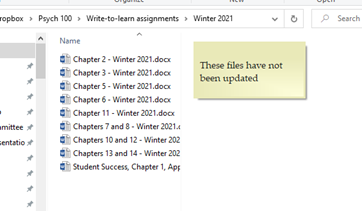
Notezilla works with websites. Here I’ve added three sticky notes to my Google calendar for this week. Any time I visit this webpage, I will see all three sticky notes.
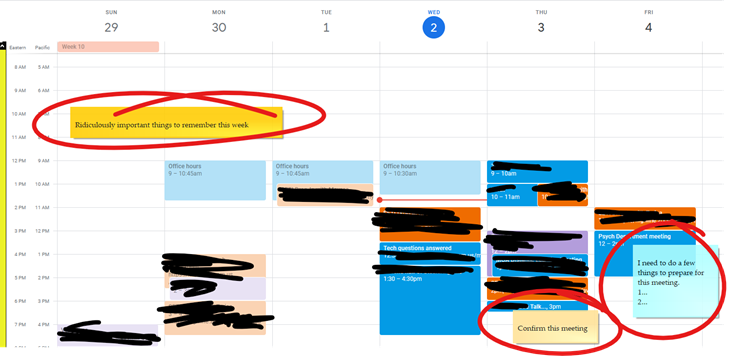
Notezilla works with programs. Here I’ve added a sticky note to my desktop Outlook. When I launch Outlook, the sticky note appears.
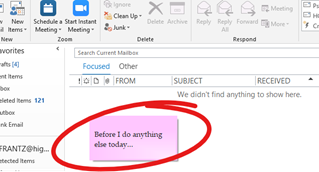
Notezilla will also happily add sticky notes to your desktop and to files. It will not, however, add sticky notes to your fridge.
How Notezilla works
Notezilla resides in your Windows system tray. If the Notezilla icon is only seen by clicking the up arrow in your system tray, you can click and drag the icon down on the bar.
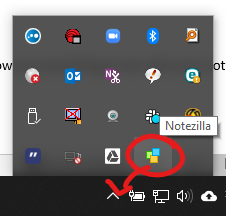
After dragging it, it will always be visible.

When you need to create a new sticky note, left-click on the Notezilla icon in the system tray and select New Note. Or use the keyboard shortcut: CTRL + SHIFT + U. And, yes, you can change this shortcut in Notezilla’s preferences (right-click on the system tray Notezilla icon, and select Preferences. Click the Hotkeys tab.)
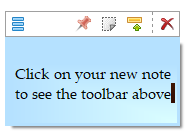
Click the 3-bar menu icon to do any number of actions. By default, your new sticky note will be attached to your desktop. If you want to attach it to something else, select “Stick to Window” (or use the keyboard shortcut: CTRL + w). Notezilla will show you everything it can stick your note to—basically, it’s everything you have open and probably some things that are running in the background. Explore the features on this menu at your leisure.
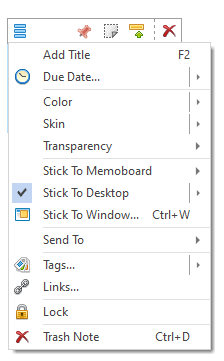
On the sticky note’s main toolbar, you have a few additional tools.
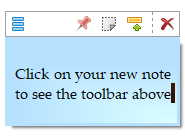
- The pushpin icon will keep your sticky note on top, which only seems to be relevant to desktop sticky notes.
- The white square icon will hide your sticky note. It’s a temporary hide. If your sticky note is attached to a folder, for example, minimize the folder and then maximize it, your sticky note will reappear. For hidden desktop sticky notes, left-click on the Notezilla icon in the system tray and select “Show all desktop notes.”
- The yellow bar/green arrow icon will “fold” your sticky note so you’ll only see the first line.
- The red X icon will delete your sticky note.
Stuff to be aware of
There may be a delay of a second or so for your sticky note to appear/disappear. For example, for the sticky note I have attached to a file folder, when I minimize the folder, the sticky note remains for a second before disappearing. When I maximize the folder again, the sticky note takes a second to reappear. That same delay happens for my other sticky notes, such as those that I have for websites. I can live with the delays.
When I was first using Notezilla, I’d create a new sticky note that I wanted to attach to a page, but I’d forget to actually do that. By default, all new sticky notes are added to the desktop. If you want to add a sticky note to something else, you need to remember to click on the 3-bar menu icon and select “Stick to Window” or use the keyboard shortcut: CTRL + w.
You can try a fully functioning Notezilla for free for 30-days. When you’re ready to purchase it, visit the Buy Now page. You can select the “subscription plan” ($14.95/year plus $15.00 for the first year; comes with free major upgrades) or the “one time payment plan” of $29.95 (free minor upgrades, but not major ones). Since I don’t know how often they do major upgrades, I opted for the one-time payment plan. Once you get your registration code, right-click on the Notezilla icon in the system tray, mouse over “Help,” and select “Register…” Step one will take you to the Buy Now page. Step two is where you’ll enter your registration code.
Check out Notezilla’s tutorials, which includes handy videos of the different features.
Happy sticky-noting!

